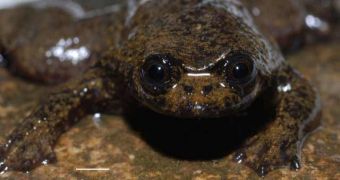So far, scientists have known about some salamanders (of the family Plethodontidae) and caecilians (worm-like amphibians) that had lost their lungs. Now they can add a frog on the list of lungless tetrapod vertebrates: the Kalimantan jungle toad (Barbourula kalimantanensis). This amphibian takes all the oxygen it needs through its skin. It is also one of the rarest frogs in the world: the species was discovered 30 years ago, but only one other specimen was found.
"Because these specimens were so rare, they had never been dissected," said David Bickford, an evolutionary biologist at the National University of Singapore, whose team describes the new finding in an article to be published in the journal "Current Biology." These toads, not longer than 2 in (5 cm), inhabit cold fast rivers in remote areas of the rainforests of the Indonesian part of Kalimantan (Borneo) Island, divided between Indonesia, Malaysia and Brunei.
The animals are slippery "and can be surprisingly fast for short bursts. We had a team of 11 people looking for these frogs and it took us almost two weeks before we found any," said Bickford.
And the species lives in extremely cold water. "After just 45 minutes of snorkeling, I would have to stop because I was shaking uncontrollably, my lips were blue, and my breathing became too labored to actually snorkel effectively. This is lowland rain forest in Borneo, just off the equator, and I had hypothermia!" Bickford told LiveScience.
The initial dissections of the frogs revealed they lacked lungs and the rest of the internal organs filled the space devoid of lungs. "So we had the stomach, spleen and the liver up in the area where lungs are normally found. Interestingly, we also discovered some abnormal cartilage around the area where the lungs should have been that we are still investigating," said Bickford.
The lack of lungs helps the frogs to significantly flatten their bodies, while the skin has an increased surface that helps them deal with oxygen absorption in the oxygen-rich cold waters. Having no lungs, the frogs will also rather sink than float, being drifted away in the water.
Being cold-blooded, "their inherent energy requirements are very small - roughly 10% that of a similar sized mammal. If you don't need as much oxygen anyhow, it might be easier to change, to lose lungs as the primary respiration organ," said Bickford.
The closest relative of this species, the Philippine flat-headed frog (Barbourula busuangensis) inhabits the Busuanga Island (in western Philippines, just east off Borneo) and it has lungs. Both species belong to the family of the fire-bellied toads (Bombinatoridae), one of the most primitive families of living frogs.
"This basically means we know where the evolutionary change occurred and we roughly know when it could have happened - not before those two species split. We will need to do some comparative studies between the Borneo species and the Philippine species to help us understand the ecological, developmental and genetic mechanisms for this exciting evolutionary event," said Bickford.
Still, the Borneo jungle toad remains a poorly known amphibian. "We don't even know what they eat, although we have some good guesses from two full stomachs. How do they locate and attract mates? What do their eggs look like? Do they even lay eggs, or do they have a more derived mode of reproduction where the eggs directly develop into small frogs? Do they have tadpoles? What are their habitat requirements? How many are left? The rarity of this frog could hamper further studies into it," added Bickford.
And the species is facing habitat loss and contamination. "The once cool and clear streams have mostly turned murky and warm, contaminated with human pollutants, run-off from agriculture and mercury from the gold mining. This is an endangered frog that we know practically nothing about, with an amazing ability to breathe entirely through its skin, whose future is being destroyed by illegal gold mining by people who are marginalized and have no other means of supporting themselves," said Bickford.
That's why the researchers are decided now to gain more support for protecting the last wild areas in Borneo, "and I think we have a flagship species in these lungless frogs," added Bickford.
One case of frog breathing mainly through its skin is the Titicaca Water Frog (Telmatobius culeus), only found in Lake Titicaca, at 3,815 m (12,720 ft) above sea level both in Peruvian and Bolivian territories. Because of the lower oxygen content in and around the lake, T. culeus respires mainly through its skin.

 14 DAY TRIAL //
14 DAY TRIAL //